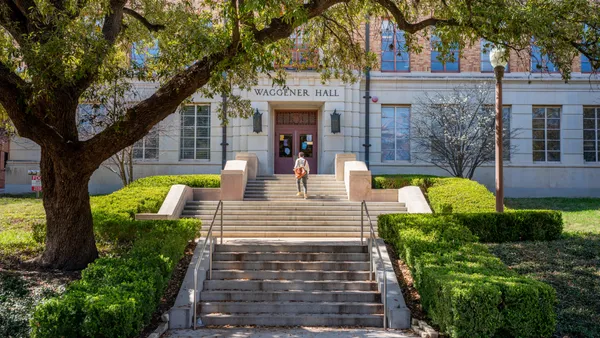In the last month, the coronavirus has swept through China, sickening tens of thousands of people and shutting down entire cities as well as some travel to and from the region. Although the outbreak has affected a limited number of people outside of China, its impact is apparent across a wide swath of industries and sectors.
For many U.S. colleges, it coincided with the start of the academic term. That has presented a host of challenges: ensuring students who can't make it back to campus can keep up with their studies and accommodating those who arrive late. With students from China making up about one-third of international students in the U.S., that could be a significant task.
The situation has also pushed schools to address racism directed at students of Asian descent and to prepare for the possibility that the virus will hit their campus.
Colleges with campuses in China have been affected more directly. New York University has turned to remote communication and instructional technology at its Shanghai campus, which so far has been delayed from opening until Feb. 17. About half of the 1,500 students there are are Chinese nationals. Uncertain about when travel to the region will reopen, the university expects to rely on a mix of digital and classroom-based instruction this semester.
While NYU has had to respond to situations in which students are unable to get to or from a campus, the scale of the current outbreak is "unprecedented," said Clay Shirky, the university's vice provost for educational technologies. For colleges, he added, "The more you have a global footprint, the more you are exposed to it."
We talked with Shirky about how NYU is adapting its instruction to deal with the impact of the coronavirus, and what the response could mean for ed tech instruction broadly. Because Shirky made a name for himself prior to joining higher ed administration as a critic of the sector's approach to technology, we also took the opportunity to ask him how the move has impacted his views.
Editor's note: This interview has been edited and condensed.
EDUCATION DIVE: What has the approach been for students in China and at the Shanghai campus so far?
SHIRKY: Improvise in the short-term, plan for the long-term. We were on our way to starting classes for the semester at our New York City campus. Once we had short-term accommodations in place for students who wouldn't be able to get back to the U.S., which are mostly what you'd expect — video conferencing and the like — we turned our attention to Shanghai. Its semester started later, so there was more lead time. That group also is well-acquainted with the design principles for online learning.
In the beginning, our team would work 24 hours a day. We would work till 8 or 9 p.m., hand off to Shanghai in its morning, and they would work till 8 or 9 p.m., then hand off to us. They were even working later than that because that's really the epicenter.
Have you had to bring in additional platforms or partners, or change the way you work with existing partners?
SHIRKY: We've used Zoom much more intensively as a result of this. People are becoming familiar with the video conferencing platform, not just in the kind of introductory walkthrough way, but having an intuitive sense of how to use it. It's still early days. We'll do an after-action review to figure out what we've learned from the short-term accommodations that we want to keep versus what were just improvisations during a crisis.
How long do you expect the situation will affect the Shanghai campus?
SHIRKY: That has been, in a way, the core question. Our original reaction was that we would be improvising for two weeks. We were essentially saying, "Students are coming to the campus in three or four days; we want to hold this together through the add-drop period." We were thinking 18 to 20 days out. But the crisis outran anybody's ability to keep up with it. By the time we had the first set of accommodations announced and distributed, flights started getting canceled, the lockdowns came to big cities in China, and the U.S. announced that some foreign nationals who had come from China in the last 14 days would be turned away at the border.
At that point we said, because this will go until at least the midterm, we're going to have to deal with high-stakes testing online, we're going to have to deal with proctoring. We're basically putting together a semester. When flights resume people will get on them, but out of an abundance of caution we're assuming the academic ramifications of the virus could continue through the end of the semester, even if new cases tail off much sooner, as we all hope they do.
So you've committed that, at least in Shanghai, this is going to be a mostly online semester?
SHIRKY: We've committed to offering an online option to students who can't get to Shanghai. In the beginning, that's everyone because the academic building is not occupiable yet. We began fully online and the adaptation is going to be hybridization in the second half of the semester. As faculty and students return, how do we run both the classroom and an online version of these classes? It will be a hardship on the faculty. It's not going to be turning a switch between fully online and fully in-person. Everyone understands the crisis, everyone is leaning into this.
The outbreak is testing the idea of mass work-from-home policies. Do you feel the same about the ed tech infrastructure and notions about how education can be delivered?
SHIRKY: Absolutely. The distinction I've constantly tried to draw when talking to deans and faculty is between remote instruction versus courses designed to be delivered online. Remote instruction is fine as a short-term accommodation. When we had students coming to New York and the guidance around coronavirus was that Americans who'd been in the region recently should self-isolate for 14 days, we said, "We don't need new policies for that because we wrote the original proposals to deal with about a 14-day absence from class while keeping the student on track."
So that remains as a short-term option. But I think this situation is going to demystify for the Shanghai faculty what it's like to teach online. Some of them will take a special liking to it, some of them will simply accept that it's possible, but it's not going to seem odd and futuristic anymore. This change is simply going to mean people recognize that this is not some shiny new future, this is just a tool we can use in education.
You chair NYU's Future of Technology-Enhanced Education Committee. What are its big priorities right now?
SHIRKY: The big priority for this year has been changing our learning management system. We're also working on questions of intellectual property for faculty producing digital materials. And we have a committee improving the training we give graduate students for teaching with technology. We consider it part of what a graduate student should learn if they want a career in academia.
Also, I'm leading a committee that's trying to convince people to stop using the phrase "digital native" to refer to our students. There's a whole variety of practices and experiences students come in with, and it's not fair on the part of the faculty to say, "They're digital natives, I don't need to think about technology because they're so good at it."
Has that led to any change?
SHIRKY: Not yet, but its pretty clear what the action items are going to be. Using the language of "digital native" in the classroom risks shutting out people who most need to feel comfortable raising their hand and saying, "Can you show me how this tool works?" There's zero guarantee that someone who has total felicity with standard apps on the phone understands how to work with digital tools for code manipulation or data visualization. So we're saying to faculty, to the degree that you assign a tool, you also need to provide students who don't know how to use that tool with resources to learn.
In 2014, you wrote that higher education institutions are "perfectly adapted to an environment that no longer exists." Now that you've become a higher ed administrator, how has your view changed on what ed tech can be?
SHIRKY: I've become one of the meddlesome bureaucrats I used to rail against. From where I am now, it has become apparent that what constitutes an ed tech company is not that the technology is educational but that the company is optimized for a sales cycle to universities.
At NYU, when we're thinking about educational tools, we’re asking whether it helps a faculty member create an experience the student can learn from. When you apply that litmus test, Wikipedia and YouTube pass and many ed tech tools fail. We are — and this gets back to the LMS — very interested in the ability to integrate third-party tools and we are very uninterested in whether a company considers itself educational.





















